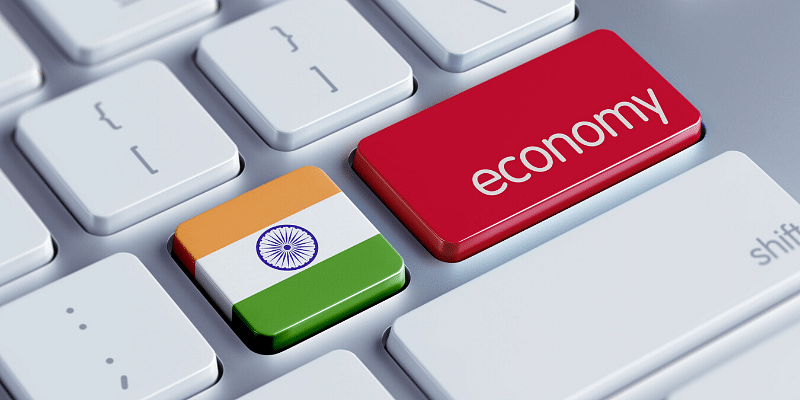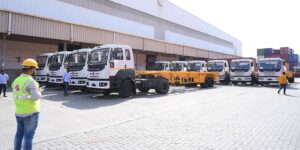
From helping the world deal with the Y2K crisis (the Millennium Bug in the global IT sector) to ensuring economic resilience during the gloomy days of the pandemic, India has successfully overcome every challenge.
This resilience is mirrored in the country’s growth, where the GDP grew 13.5% in the April-June quarter from a year ago, registering its fastest annual expansion in a year. S&P Global Ratings projects India’s GDP to grow around 8% for the next three fiscal years, among the fastest in large and developing economies.
As per the Global Innovation Index 2021 ranking, India is the top innovative country in central. The numbers don’t stop here. NASSCOM also ranked India as the 3rd largest startup ecosystem with 200 active angels, more than 100 accelerators, 150 VCs, and around 77,000 startups operating nationwide. India is at the forefront of innovation, entrepreneurship, and technology, and the last two years have only added more to its startup ecosystem.
With Bengaluru once seen as the leading Silicon Hub, dynamic new centres for innovation and development are skyrocketing. To the North, there’s Delhi, and to the South, Chennai and Hyderabad. India is betting heavily on technology and innovation, eyeing the possibility of being a $10 trillion economy by 2030.
In his remarks to the thousands of students who participated in the Smart India Hackathon 2022 Grand Finale, Prime Minister Narendra Modi said that the nation has advanced “rapidly” and that “revolutions” are happening in many sectors.
Role of India in the global innovation revolution
Lately, innovation has played a crucial role in developing emerging markets, and strengthening existing ecosystems worldwide, especially in India. The country is poised to improve its Global Innovation Index rankings by 41 places from a mere 81st rank in 2015 to 40th rank in (World Intellectual Property Organisation). Additionally, India’s rank in the ease of doing business has improved from 142nd in 2014 to 63rd in 2022, according to the World Bank.
Combined, conscious and coordinated efforts of the Central and State governments to make India a global center of research and innovation are becoming a reality. For instance, Unified Payments Interface (UPI), developed by the National Payments Corporation of India (NPCI), has transformed peer-to-peer transactions in India, giving way to a number of successful Fintech startups. In September 2022 alone, a total of $140 Billion was transacted in 6.7 billion transactions, with several countries looking to adopt this system.
Making India a technological Hub of the World
Since the advent of COVID-19, the demand for digitisation and technological advancements has accelerated. Marking India’s journey towards self-reliance in technology, Prime Minister Narendra Modi, on India’s 75th Independence Day, added ‘Jai Anusandhan’ to the famous slogan of ‘Jai Jawan’, ‘Jai Kisan’ and ‘Jai Vigyaan’.
‘Investing in R&D’ and ongoing Government schemes like ‘Skill India’ would have put India in a better position to compete with China in technology-driven markets. India must significantly increase its focus on digital engineering to be the leader in technology innovation based on the explosive growth and expansion of the Internet of Things (IoT), Industry 4.0, Artificial Intelligence, and software-defined networking.
Along this trajectory of growth and transformation, Software as a Service (SaaS) is setting the stage for the next wave of disruption. The Indian SaaS market is expected to grow multi-fold by 2025, accounting for almost 7% to 10% of the global SaaS market from 2% to 4%.
<div class="alsoread" data-title="Services, products, startups: how India’s IT sector has built resilience, innovation, and global trust" data-thumbnail="https://images.yourstory.com/cs/2/28b451402d6a11e9aa979329348d4c3e/Odds-1667549351300.png?fm=png&auto=format&h=100&w=100&crop=entropy&fit=crop" data-published-url="https://yourstory.com/2022/11/india-it-sector-technology-startups-entrepreneurship-resilience" data-brand="yourstory" data-head-line="1169 people loved this story” contenteditable=”false” data-new-ui=”true” data-explore-now-btn-text=”undefined” data-group-icon=”https://images.yourstory.com/assets/images/alsoReadGroupIcon.png” data-headline=”1169 people loved this story”>
display:flex !important;
z-index: 10 !important;
margin-top: 15px !important;
justify-content: flex-end;
.exploreNowBtn
background: black;
color: white;
padding: 10px;
width: 154px;
border-radius: 6px;
font-size: 14px;
line-height: 17px;
float: right;
cursor: pointer;
text-align:center;
border-bottom: unset;
font-weight: 600;
height: 37px;
border: 1px solid black;
font-family: ‘museo-sans’ !important;
font-style: normal !important;
text-transform: capitalize !important;
.highLightLine
color: #FF512F !important;
.bottomLineStyle
width: auto;
margin: 10px 0px 20px;
border: 0.5px dashed #BFBEBE;
width: 90% !important;
.textWrapperStyles
width: 100%;
display: flex;
flex-direction: column;
justify-content: space-between;
padding: 0.25rem 0.5rem 0.25rem 1.5rem !important;
position: relative;
margin: 0;
min-height: 6.62rem;
padding-top: 0;
.anchorStyle
text-decoration: none;
color: black !important;
width: 100%;
.thumbnailWrapperStyles
text-align: center;
margin-right: 1.2rem;
.innerWrapperStyles
font-family: ‘museo-sans’ !important;
display: flex;
margin: 0;
border-radius: 12px;
// align-items: center;
;
.exploreNowText
color: white !important;
font-size: unset !important;
font-family: unset !important;
font-weight: unset !important;
margin: unset !important;
line-height: unset !important;
letter-spacing: unset !important;
.headLineText span
font-weight: 800 !important;
font-size: 28px !important;
.thumbImage
display: unset !important;
height: auto !important;
margin: unset !important;
.exploreNowCheron
border: 0px;
padding: 0px;
vertical-align: middle !important;
display: unset !important;
height: 73% !important;
margin: unset !important;
width: 7% !important;
margin-left: 5px !important;
color:white;
opacity : 1;
.alsoReadTitleDescr
font-size: 22px !important;
font-weight: 400 !important;
line-height: 29px !important;
color: #242626 !important;
font-family: ‘museo-sans’ !important;
font-style: normal !important;
text-transform: capitalize !important;
.alsoReadMainContainer
font-size: 1rem;
padding-bottom: 1.1rem;
color: #171B1C;
width: auto !important;
padding: 1.5rem 1.875rem;
// margin: 1rem 0rem !important;
background: linear-gradient(90deg, rgba(255, 81, 47, 0.1) 0%, rgba(240, 152, 25, 0.1) 100%);
box-shadow: 0px 0px 30px rgba(86, 128, 151, 0.1);
border-radius: 12px;
height: 100%;
display: block;
.headLine
min-height: 3.5rem;
// font-size: 25px;
font-family: ‘museo-sans’;
font-weight: 500;
color: #000000 !important;
@media (max-width: 769px)
.exploreNowCheron
display: none !important;
.exploreNowBtn span
border-bottom: 2px solid red !important;
padding-bottom: 3px !important;
.exploreNowBtn
// border-bottom: 2px solid red !important;
border-radius: 0px !important;
width: 86px !important;
background: unset !important;
color:black !important;
border: 0px !important;
padding: 10px 0px 5px 0px !important;
font-weight: 700 !important;
height: 43px !important;
border: 1px solid unset !important;
.alsoReadTitleDescr
font-size: 16px !important;
font-weight:500 !important;
line-height: 20px !important;
padding: 0px !important;
color: black !important;
.headeLine
line-height: 1.2 !important;
.innerButtonWrapper
padding-right: 0px !important;
.thumbImage
height: 29px !important;
width: 23px !important;
.alsoReadMainContainer
padding: 1.5rem 1.6rem 1em !important;
.exploreNowText
color: #10171B !important;
font-weight: 600 !important;
font-size: 14px !important;
margin: unset !important;
line-height: unset !important;
letter-spacing: unset !important;
text-transform: capitalize !important;
font-style: normal !important;
.headLineText span
font-weight: 800 !important;
font-size: 20px !important;
margin: unset !important;
line-height: unset !important;
letter-spacing: unset !important;
Services, products, startups: how India’s IT sector has built resilience, innovation, and global trust
Next wave of Metaverse and Web3
Metaverse became a household name when Facebook changed the name of its parent company to Meta. This change was an attempt to unravel a world built in XR (a combination of augmented reality, mixed reality and virtual reality) known as Metaverse.
The digital twin of a person (DToP) and the Digital twin of a customer (DToC) are the two upcoming innovative tools explored in the Metaverse world. The Metaverse market is projected to grow from $100.27 billion in 2022 to $1,527.55 billion by 2029, exhibiting a compounded annual growth rate (CAGR) of 47.6% during the forecast period.
Prior to Facebook’s rebranding exercise, a few countries had a headstart exploring this emerging tech. In South Korea, for example, the metaverse is used for hosting virtual meetings using Ifland, a platform developed by SK Telecom where users can participate with digital avatars. In the United Arab Emirates (UAE), a virtual version of Dubai city, called ‘MetaDubai’, is being built in the metaverse.
Metaverses are combinatorial innovations that depend on various technologies and trends. The Internet of Things (IoT), augmented reality, cloud, flexible work methods, head-mounted displays (HMDs), artificial intelligence (AI), NFTs, Web3, spatial computing, and 5G are some of the trends that are contributing to this. Recently,
At the India Mobile Congress, PM Modi launched 5G technologies in India, donned glasses with metaverse technology and highlighted its importance in the future. India is now working on Central Bank Digital Currency (CBDC) and testing quantum communication technology.
How 5G will change the game
The 5G network will disrupt OTT consumption, bringing about a digital transformation and network virtualisation across sectors. It will have an increased speed over existing capacity of current mobile networks, reduced energy use under a single network to provide a variety of heterogeneous services like AI, extended reality (XR), edge computing, and IoT.
India has over 658 million internet users, making it the second-largest digital population after China, with a likelihood of reaching 1.134 billion by 2025. The flood of low-cost smartphones and laptops, combined with relatively low-cost mobile plans (wave of Jio), has enabled people across the country, especially in rural India, to access the Internet.
Earlier this month, the Indian government took India’s digital transformation to the next phase with the launch of 5G services. The advent of 5G in India could transform the economic fabric of the country, by empowering a number of ecosystem players to build private networks ushering in a new digital age. From a digital connectivity perspective, it is pivotal in steering the country towards embracing, steering and leveraging emerging technologies.
<div class="alsoread" data-title="Ecommerce in the era of 5G" data-thumbnail="https://images.yourstory.com/cs/2/c5c652a0fb5a11eca125d7821ea2fbc4/shutterstock1663007959Converted-1666088099852.png?fm=png&auto=format&h=100&w=100&crop=entropy&fit=crop" data-published-url="https://yourstory.com/2022/10/ecommerce-era-5g-live-commerce-video" data-brand="yourstory" data-head-line="1495 people loved this story” contenteditable=”false” data-new-ui=”true” data-explore-now-btn-text=”undefined” data-group-icon=”https://images.yourstory.com/assets/images/alsoReadGroupIcon.png” data-headline=”1495 people loved this story”>
display:flex !important;
z-index: 10 !important;
margin-top: 15px !important;
justify-content: flex-end;
.exploreNowBtn
background: black;
color: white;
padding: 10px;
width: 154px;
border-radius: 6px;
font-size: 14px;
line-height: 17px;
float: right;
cursor: pointer;
text-align:center;
border-bottom: unset;
font-weight: 600;
height: 37px;
border: 1px solid black;
font-family: ‘museo-sans’ !important;
font-style: normal !important;
text-transform: capitalize !important;
.highLightLine
color: #FF512F !important;
.bottomLineStyle
width: auto;
margin: 10px 0px 20px;
border: 0.5px dashed #BFBEBE;
width: 90% !important;
.textWrapperStyles
width: 100%;
display: flex;
flex-direction: column;
justify-content: space-between;
padding: 0.25rem 0.5rem 0.25rem 1.5rem !important;
position: relative;
margin: 0;
min-height: 6.62rem;
padding-top: 0;
.anchorStyle
text-decoration: none;
color: black !important;
width: 100%;
.thumbnailWrapperStyles
text-align: center;
margin-right: 1.2rem;
.innerWrapperStyles
font-family: ‘museo-sans’ !important;
display: flex;
margin: 0;
border-radius: 12px;
// align-items: center;
;
.exploreNowText
color: white !important;
font-size: unset !important;
font-family: unset !important;
font-weight: unset !important;
margin: unset !important;
line-height: unset !important;
letter-spacing: unset !important;
.headLineText span
font-weight: 800 !important;
font-size: 28px !important;
.thumbImage
display: unset !important;
height: auto !important;
margin: unset !important;
.exploreNowCheron
border: 0px;
padding: 0px;
vertical-align: middle !important;
display: unset !important;
height: 73% !important;
margin: unset !important;
width: 7% !important;
margin-left: 5px !important;
color:white;
opacity : 1;
.alsoReadTitleDescr
font-size: 22px !important;
font-weight: 400 !important;
line-height: 29px !important;
color: #242626 !important;
font-family: ‘museo-sans’ !important;
font-style: normal !important;
text-transform: capitalize !important;
.alsoReadMainContainer
font-size: 1rem;
padding-bottom: 1.1rem;
color: #171B1C;
width: auto !important;
padding: 1.5rem 1.875rem;
// margin: 1rem 0rem !important;
background: linear-gradient(90deg, rgba(255, 81, 47, 0.1) 0%, rgba(240, 152, 25, 0.1) 100%);
box-shadow: 0px 0px 30px rgba(86, 128, 151, 0.1);
border-radius: 12px;
height: 100%;
display: block;
.headLine
min-height: 3.5rem;
// font-size: 25px;
font-family: ‘museo-sans’;
font-weight: 500;
color: #000000 !important;
@media (max-width: 769px)
.exploreNowCheron
display: none !important;
.exploreNowBtn span
border-bottom: 2px solid red !important;
padding-bottom: 3px !important;
.exploreNowBtn
// border-bottom: 2px solid red !important;
border-radius: 0px !important;
width: 86px !important;
background: unset !important;
color:black !important;
border: 0px !important;
padding: 10px 0px 5px 0px !important;
font-weight: 700 !important;
height: 43px !important;
border: 1px solid unset !important;
.alsoReadTitleDescr
font-size: 16px !important;
font-weight:500 !important;
line-height: 20px !important;
padding: 0px !important;
color: black !important;
.headeLine
line-height: 1.2 !important;
.innerButtonWrapper
padding-right: 0px !important;
.thumbImage
height: 29px !important;
width: 23px !important;
.alsoReadMainContainer
padding: 1.5rem 1.6rem 1em !important;
.exploreNowText
color: #10171B !important;
font-weight: 600 !important;
font-size: 14px !important;
margin: unset !important;
line-height: unset !important;
letter-spacing: unset !important;
text-transform: capitalize !important;
font-style: normal !important;
.headLineText span
font-weight: 800 !important;
font-size: 20px !important;
margin: unset !important;
line-height: unset !important;
letter-spacing: unset !important;
Make in India: Big push to make India a Manufacturing Powerhouse
The government is looking within its borders to build resilient infrastructure and reduce dependence on external sources to avoid uncertainties. The most striking example of this was the launch of the ‘Make in India’ initiative in 2014, which facilitated investment, innovation, enhanced skill development, and best-in-class manufacturing infrastructure in the country to achieve its vision of a self-reliant country, also known as ‘Atmanirbhar Bharat’.
Path-breaking reforms in these eight years have led to substantial accomplishments across sectors and create manufacturing jobs for the youth of this country.
Besides backing Make in India, the push promoted local brands and startups, supply chains, and manufacturing so businesses can scale globally. This had a seismic impact on the startup ecosystem. For instance, Apple is now manufacturing its top iPhone Models – 13 and 14 in Sriperumbudur, Tamil Nadu. Similarly, Tata and Airbus announced the manufacturing of C-295 transport aircraft for the Indian Air Force in Vadodara, Gujarat. These landmark achievements of the Government’s Make in India Campaign.
India has managed to overcome a number of obstacles like the shift in economic environments, a global pandemic, the dearth of infrastructure, and inefficiencies within the governance system. This decade in many ways is crucial.
India is head-first transitioning to a green economy as seen by initiatives like Panchamrit at the Glasgow Summit, the intended nationally determined contribution (INDC) aims to combat climate change and the National Action Plan for Climate Change.
The Digital India movement, semiconductor manufacturing, 5G rollout, and spreading of the optical fibre network is not just a journey towards self-reliance but the next revolution in education, health services setting the tone for India’s next tech-led decade.










